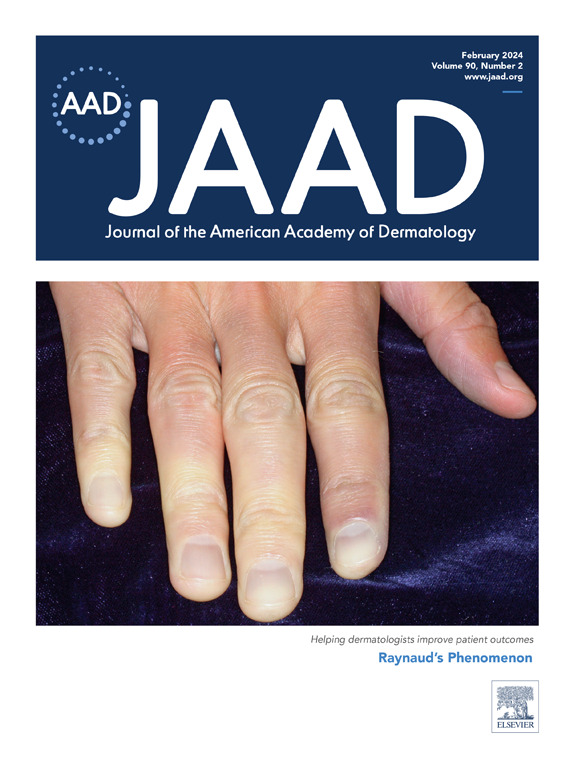皮肤外科医生在最初无法确定非黑色素瘤皮肤癌部位时如何决定继续手术?一项全国性、多中心、前瞻性研究。
IF 11.8
1区 医学
Q1 DERMATOLOGY
引用次数: 0
摘要
背景:很少有研究显示皮肤外科医生是如何处理肿瘤部位识别问题的:估计当肿瘤的解剖位置存在问题时,通过手术治疗皮肤癌的频率和处理方法:方法:全国性、前瞻性、多地点队列研究:在22个中心的17,076个病例中,98例(0.60%)是最初无法确定部位的可疑病变(LIQ),这些病例多见于男性、年龄较大且活检时间超过30天的患者。外科医生平均使用了 5.0(95% CI:4.61-5.39)种额外的方法来确认病变部位,常见的方法包括:重新检查现有文件(90 例病变,92%);扩大体格检查范围(89 例病变,91%);让患者用镜子指认(61 例病变,62%)。有 15%的患者要求活检提供者提供照片,还有 15%的患者进行了冷冻切片活检。10%的患者联系了转诊医生。最终,外科医生成功确定了82%(80/98)最初不确定的部位,其余18%(18/98)被推迟。大多数推迟手术的部位都不是面部:局限性:手术地点均为学术中心:结论:当肿瘤的解剖位置不确定时,皮肤外科医生会使用多种方法来确定部位,有时病例会被推迟。本文章由计算机程序翻译,如有差异,请以英文原文为准。
How dermatologic surgeons decide to proceed with surgery for nonmelanoma skin cancer when site identification is initially uncertain: A nationwide, multicenter, prospective study
Background
Few studies show how dermatologic surgeons manage problems with site identification.
Objective
To estimate frequency and characterize management of skin cancer treated by surgery when the anatomic location of the tumor is in question.
Methods
Nationwide, prospective, multisite cohort study.
Results
Among 17,076 cases at 22 centers, 98 (0.60%) were lesions in question for which site identification was initially uncertain, with these more often in patients who were male, older, and biopsied more than 30 days ago. Surgeons employed on average 5.0 (95% CI: 4.61-5.39) additional techniques to confirm the site location, with common approaches including: re-checking available documentation (90 lesions, 92%); performing an expanded physical examination (89 lesions, 91%); and asking the patient to point using a mirror (61 lesions, 62%). In 15%, photographs were requested from the biopsying provider, and also in 15%, frozen section biopsies were obtained. In 10%, the referring physician was contacted. Eventually, surgeons succeeded in definitively identifying 82% (80 of 98) of initially uncertain sites, with the remaining 18% (18 of 98) postponed. Most postponed surgeries were at non-facial sites.
Limitations
Sites were academic centers.
Conclusions
When the anatomic location of the tumor is uncertain, dermatologic surgeons use multiple methods to identify the site, and sometimes cases are postponed.
求助全文
通过发布文献求助,成功后即可免费获取论文全文。
去求助
来源期刊
CiteScore
8.60
自引率
5.80%
发文量
2023
审稿时长
49 days
期刊介绍:
The Journal of the American Academy of Dermatology (JAAD) is the official scientific publication of the American Academy of Dermatology (AAD). Its primary goal is to cater to the educational requirements of the dermatology community. Being the top journal in the field, JAAD publishes original articles that have undergone peer review. These articles primarily focus on clinical, investigative, and population-based studies related to dermatology. Another key area of emphasis is research on healthcare delivery and quality of care. JAAD also highlights high-quality, cost-effective, and innovative treatments within the field. In addition to this, the journal covers new diagnostic techniques and various other topics relevant to the prevention, diagnosis, and treatment of skin, hair, and nail disorders.

 求助内容:
求助内容: 应助结果提醒方式:
应助结果提醒方式:


